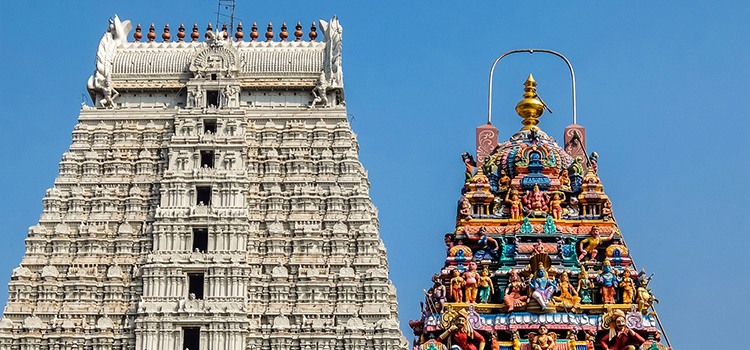A man’s life becomes unfulfilled without a progeny. Some people are devoid of this blessing. How much ever rich a man in his life, living a life childless creates emptiness. Karuvalarcheri is a temple located near Kumbakonam, Tamil Nadu. Akhilandeswari Amman is the principal deity. She blesses women who wish to have children. Women visit the temple and perform pooja for this cause. Agastheeswara is the name of Lord Shiva in this temple. Goddess is also known as Bandaraga Vardhini in Sanskrit.

The Karuvalarcheri Amman temple is a renowned temple situated in Tamilnadu. It is at a distance of 2 kilometers from Marudanallur on Kumbakonam-Mannargudi Road. It is one of the major temples of the Agastya Siddha lineage. This temple is also known as Agastheeswarar Karuvalacheri temple. Marudanallur is “Devara padal petra sthalam”. ( Devotional hymns in praise of Lord Shiva’s glory ).
Karuvalarcheri derives its name from “Karu”=fetus or embryo; “Valar”=to grow; “Cheri”=the place.
Karuvalarcheri Akhilandeswari Amman is also known as Karuvalarakkum Nayagi. It means, the Goddess who gives her blessings to the growing fetus. The Goddess of the temple blesses the unborn fetus and protects it. According to Agasthiyar Nadi, the seed of birth forms at the feet of the Goddess of this temple.
Garbaraksambiga temple is nearby. The principal deity there is Garbarakshambiga, who protects the fetus in the womb. Karuvalarcheri temple compliments Garba Rakshambiga temple at Thirukkarugavur. Next to the temple is the temple of Sri Lakshmi Narayana. This makes the Karuvalarcheri area a Siva-Vishnu spot.
Karuvalarcheri Amman is Suyambu (self-manifested) and so abhisheka is not performed. Sambrani or Benzoin oil and Punugu are being applied. This idol emerged on its own according to the wishes of the Divine.
History:
According to the legend, Sage Agasthya got married here. Sage Agastya had the vision of Lord Shiva’s marriage at this place. Both Agastya and Devi Lopamudra visited this temple. They worshipped in this temple on Navarathri and Sivarathri days. The deity manifested herself in the form of an anthill (putru). Devotees worship her in the form of an anthill. They get blessed with a child.
Significance:
This temple is a thousand years old. Pregnant women visit the temple to seek growth and protection of the fetus in their womb. Lord Shiva carries the name “Agastheeswara” in this place. He blesses aspirants who seek higher knowledge. The immense power of Maha Guru Agashthiya’s “Padhuka Shakti” pervades this place. This helps all aspirants gain higher knowledge, as per the blessings of Sage Agastya.
Architecture:
This is a small east-facing temple built in the Dravidian style of architecture. Inside the sanctum, the Goddess is in a standing position. The Rajagopuram is three-tiered. The temple has separate shrines for Ganesha and Murugan. These two shrines are at the entrance. Nandi and Bali peetam are facing the sanctum. Both are immediately after the Rajagopuram. Agastheeswarar or Lord Shiva is facing east. He is in Linga form. Brahma, Dakshinamoorthy, Vishnu Durga, and Vinayaga are the Koshta idols. There is always a screen in front of Goddess Karu Valartha Nayagi up to chest height. The upper part is visible on normal days. The screen does not exist on the nine days of Navarathri and Shivarathri. All poojas or archanas happen only to Sri Chakra Maha Meru or Sri Chakra. There is a separate shrine for Agasthya and Lopamudra. Nagaraja, Nagakanni, and Bairava are in separate shrines. Muruga with his consorts Valli and Devanai is in a separate shrine. Navagrahas and Chandikeswarar are present in different shrines. The temple theertham is Chandra Theertham, located outside the temple.
Festivals of the temple:
The most prominent festival celebrated is Navarathri during the Purattasi month. Diwali which falls in Aippasi is also celebrated here. People pray for the development of the fetus to Goddess Akhilandeswari. Some devotees pray for a progeny. Grand celebrations take place on Fridays in Aadi.
Benefits of praying Karuvalacheri Amman :
Women who wish to have children visit the temple. They smear the steps of the sanctum of the Goddess with ghee or clarified butter. Pleased by this, the mother in turn blesses the devotees with offspring. The devotees decorate the steps with special chalk powder, turmeric, and kumkum. After the pooja is over, devotees get seven turmeric pieces and one full lemon. Each couple has to make juice out of the lemon and consume it. The lady needs to apply turmeric to her body. Before the third application of turmeric, devotees gain positive news about the pregnancy. In the case of delayed marriages, a life partner arrives soon after the temple visit. Women who perform the puja get pregnant. They come back to this temple within a few months to offer a cradle and a few bangles as an offering.
Temple timings:
Morning: 8 am – 12 noon
Evening: 4 pm – 8 pm
How to reach the temple:
By air: Trichy airport is 136 kilometers from the temple.
By Rail: The nearest railway station is Kumbakonam, 60 kilometers from the temple.
By Road: The bus stop is very near to the temple. State transport buses along with private buses connect other places often. Other than buses, private taxis, autos, and cabs are available round the clock.

